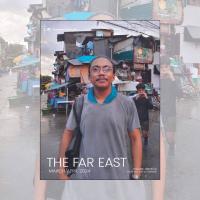
Photo: commons.wikimedia.org/20181111 Hiroshima Memorial Cenotaph-1.jpg/Balon Greyjoy/CC0 1.0
Hiroshima had been peaceful, mostly unscathed by the Allied incendiary bombs plaguing its neighbours. The odd air sortie had dropped only leaflets calling for Japan’s surrender, not the feared fireballs. Some credited this to divine protection afforded to the deeply religious Buddhist city, others the influence of the numerous second-generation Japanese-Americans with relatives in the area.
However, a more insidious rationale was driving tactics in the Allied launch pad on the island of Tinian near Okinawa. The ground was being prepared to test the destructive ability of an up-until-then unused weapon, and a pristine landscape would allow a more accurate assessment of its destructive ability.
In Hiroshima, calls to gather in emergency shelters punctuated the evening of August 5, but an uncluttered azure sky greeted the dawn. At 7:09 am, the scream of a siren broke the quiet chatter of what seemed just another day, before an all clear signal reinstated the usual work patterns of industry.
As the hands of the clock ticked towards 8:15 am, an urgent communiqué from the Japanese Military Command reached the national broadcaster in Hiroshima. The duty officer scrambled to the city’s public address system.“… three large enemy planes… over Saijo,” he began. Then an eye-stabbing flash obliterated the sun and a heaven-splitting roar rocked the earth, as if wrenching it from its orbit. The duty officer fell silent.
A United States B-59 aircraft, dubbed the Enola Gay, had dropped the first atomic bomb on an inhabited city. In the air, the crew was ebullient. “We gave it to Hiroshima” was the cry, but on the ground bodies dissolved into instant charcoal, others tossed in the air like pancakes. Many lay crushed under fallen buildings, while a message from the Enola Gay to base reported, “Results clear cut; successful in all respects.”
Tinian was jubilant. Hiroshima shattered. People stumbled over dead bodies, broken glass and the debris of a wasted city. The able searched for their loved ones. The injured walked aimlessly, the seared skin of their outstretched arms hanging like draped cobwebs adorning a Halloween party. The dead and dying lay in hideous deformity of charred skin, crushed bones and severed limbs.
At 9.00 am, black radioactive rain intensified, ceasing only around nightfall. Some thought oil was being sprayed. Dead fish floated in streams up to seven kilometres from the epicentre. Charred bodies choked the river in the city centre. Fires proliferated. The scene was described as “like hell.” Kiyoko Yoshida saw boys and girls lying on the ground “disfigured beyond recognition” pleading “water, water.” Parents could not recognise their children, asking their name to verify identity.
Rokuro Kubosaki saw two United States prisoners chained to a post. He was not sure if they were alive or dead. “I was so overwhelmed with hatred that I threw a glass bottle at them. It wasn’t those prisoners that dropped the bomb,” he later reminisced. “I regret what I did.”
Many Koreans pressed into service by the Japanese military died that day, along with students from Malaya, the Philippines, China, Borneo and Brunei studying under the Great East Asia Co-Prosperity Sphere Cultural Interchange Programme.
Screams of pain continued in Hiroshima, while cheers echoed around Tinian. In the background, Allied commanders quietly planned an incendiary bomb attack on the devastated city for the following evening and scientists made last minute preparations for a second atomic bomb to drop on Kokura. Bad weather saw the original target abandoned in favour of Nagasaki. It claimed a further 70,000 lives.
The number of dead cannot be accurately ascertained, but by the end of the year, at least 140,000 had passed away in Hiroshima alone. Far more survived to carry their disfigurement, radiation sickness and pain through the coming decades as living witnesses to the ferocity of the violence wreaked on that day 76 years ago.
There was much to repair. Within weeks, United States and Japanese experts were studying the effects of the bomb. Jointly run clinics recorded details of the progression of illness until the Supreme Commander for Allied Powers, Douglas MacArthur, called an abrupt halt to the programme, leaving a serious gaping hole in medical knowledge of radiation that affected the development of treatment for decades. His successor, Matthew Ridgeway, reinstated it.
MacArthur had done much good during the occupation, but perhaps his most important legacy to feudal Japanese society was his own demise. He was fired in 1951. As Supreme Commander, he had simply replaced one absolute authority with another, reinforcing the feudal mentality. His dismissal was a timely lesson that no human power or authority is absolute, giving people some hope of claiming more control over their own destiny.
Many words have been uttered and gestures offered in reconciliation. Mayors, bishops, world leaders, popes, philosophers and a great many more of lesser degree have spoken.
The most important message comes from the hibakusha (literally explosion-affected people), but their voices have often been muted by authorities and judged an inconvenience rather than a treasured resource. It has been Churches, temples, non-government organisations, universities and private citizens amplifying them.
Japan surrendered on August 15, but the sins of war belong to the whole world. Hiroshima and Nagasaki have magnified their impact by thousands of degrees, but it is the hibakusha and their descendants whose legacy most challenges humankind to find just and peaceful ways of settling disputes.
A common mantra says, “Lest we forget,” but what we should never forget are the words of Pope Paul VI to the United Nations in 1965, “No more war, never again war. Peace, it is peace that must guide the destinies of people and of all mankind.”
Columban Fr Jim Mulroney worked in Japan in the 1970s and 1980s.
Listen to "No more war, never again war"
Related links
- Read more from The Far East - October 2021

